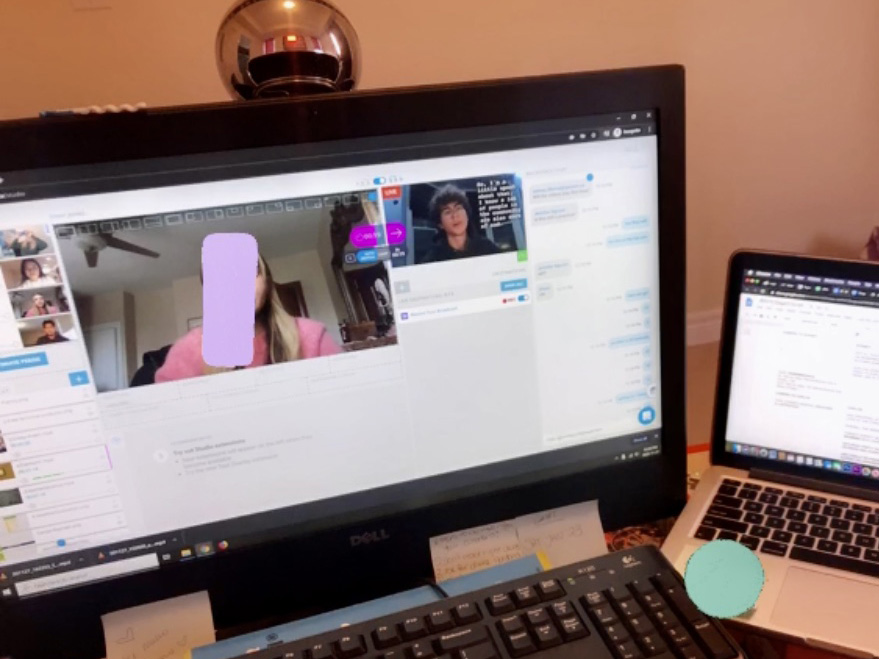And welcome to...Stage 10

News Media Production Assistant Daniela Olariu's set up for the second-year broadcasts.
The Ryerson School of Journalism had a few sticky situations when it came to teaching online this year, a transition caused by the COVID-19 pandemic. Journalism typically requires students to walk up to strangers, learn new software, and get their hands on special equipment—none of which were immediately available as the school year started.
Then there was the problem of the second-year broadcasting course. Normally students use the professional studio inside the Rogers Communication Centre; the year-end assignment consisted of creating a professional-looking broadcast.
The future of that course, also known as JRN 270, hung heavy in the air until early August, when the idea of using Stage 10 was introduced.
Stage 10 is an online software that allows users to create and distribute live video. The software allows for small editing functions like live voting buttons, or drag and drop custom graphics, but it also has a professional remote live studio. The studio replicates how an in-person broadcast would be set up, without everyone needing to be in the same room.
Academically speaking
Gavin Adamson, the professor for JRN 270 and JRN 271 had his reservations about how this semester would play out. But now that first semester has finished, he’s had a chance to evaluate how things went.
“I think overall, surprisingly well. I mean, as I've been saying all along, it was a little bit of a risk this year to try to introduce broadcasting in this kind of environment,” Adamson said. “But with a lot [of ] teamwork between the students themselves and myself and the technical staff, it really turned out very well.”
Besides the countless zoom classes and staff meetings, the concept for an online 270/271 really came together when technical staff members Lindsay Hanna and Daniela Olariu found Stage 10.
“They never said, Gavin, we have to try this. But they put it in front of me and let me make a decision.”
Adamson also mentioned his surprise at the attitude of the 270/271 students, saying they were “open-minded and enthusiastic” about the platform.
“I think to some extent, it [Stage 10] took away a little bit of pressure...but maybe being in front of your own monitor and in your own environment, in your own home, frankly, might have helped.”
Technology-wise
Daniela Olariu and Lindsay Hanna, RSJ’s news media and digital content specialists, respectively, had their hands full helping ensure the technology portion of classes operated as smoothly as possible.
“I do think it was kind of a lot at once...they [students] are used to going to the studio and the control room and seeing how everything works,” Olariu said. “With this [Stage 10], they couldn’t really see how it works. They were kind of thrown into it.”
Hanna thought the online broadcasting was less intense than the “real thing.”
“I thought it seemed less pressure-filled for them...They were shorter broadcasts to just kind of get your feet wet,” she said. “There was just a small group of us in there watching, maybe that took some of the pressure off. So it really lets you ease into it, as opposed to feeling like you're in this big, intimidating studio.”
Even with being thrown into broadcasting, Olariu didn’t believe that the work itself was any more difficult than previous years.
“In person...you're trying to handle the whole classroom, and everyone's kind of running around...whereas this is more mainstreamed.”
Many students aren’t located in Toronto this academic year, and Hanna said it allowed for some students’ creativity to flourish.
“I had a student call in, one student was in Pakistan, and one was out here in the east end of the city...They did this really sweet weather report that was like, ‘Hey, I'm here in Toronto. I'm dressed in my parka, because it's freezing cold.’ And then the other one says, ‘Here in Pakistan, I'm just wearing my sweater. It's a pretty cool day,’ and I thought, never in a million years, would we have been able to do this if it weren't for the pandemic.”
Communication-conversation
Janice Neil, chair of the school of journalism, also recognized the huge communication learning experience that came with teaching online.
“I think one of the things I realized was how much communication about courses happens verbally and in person in casual ways.” Neil said. “If you're a student who's sitting there and you've been distracted for a minute and didn't quite pay attention to whatever was said, after you leave class, and you're walking out the door, you're walking down the hallway, you can say to your friend, did she say we were supposed to do blah, blah, blah?”
That being said, Neil mentioned more positives of [social] distance learning, in the ways of instructors.
“We had one in the fall who lives in Ottawa, and we have one this winter in New York City. He works for the New York Times, so he’s teaching our fact checking course. So, yeah, he'll be live from New York!”
Overall…
Based on the overwhelming positive comments, it seems like Ryerson’s second year students were enthusiastic and willing to give anything a try. Hanna ended the broadcasting conversation with a hopeful note to the second-years.
“Truthfully, I kind of think the second years are in the best position out of maybe any of the years...Third and fourth year is when you would have been progressing into the more professional grade equipment, and I'm really hopeful you'll still have that chance. And for, say, third years who missed out on it, I believe the school will do everything they can to give them that opportunity as well. So I think you guys got to see, you know, the best of everything.”